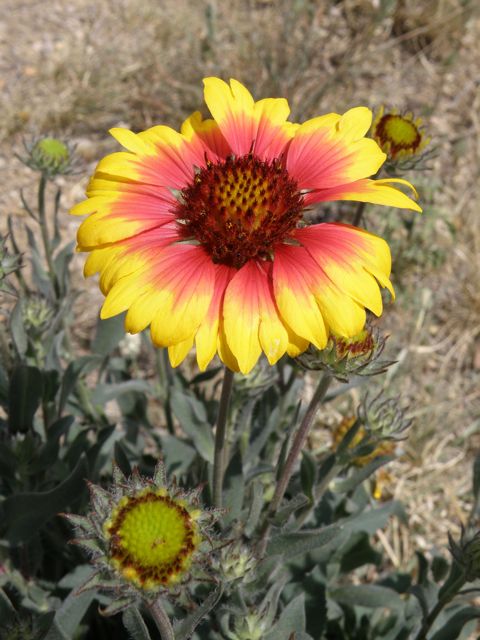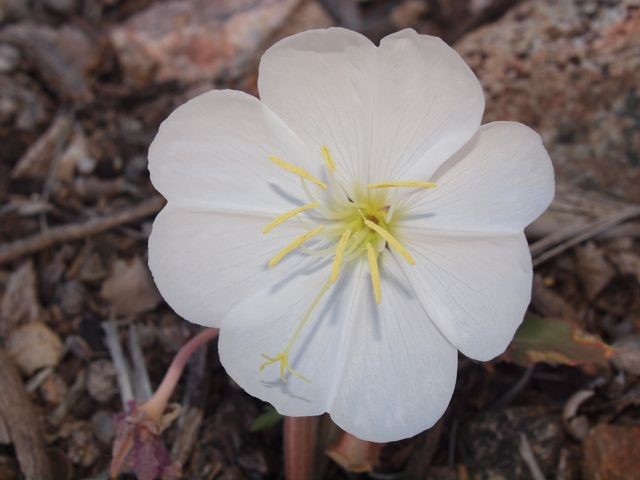 Grow a Wildflower Meadow - February 3, 2021 Jeff Schalau, Agent, Agriculture & Natural Resources University of Arizona Cooperative Extension, Yavapai County Wildflowers and native grasses are perfect for creating informal, low-maintenance landscape areas. They provide habitat for butterflies, bees, and other desirable insects as well as wild birds, reptiles, and mammals. Over time, seasonal colors change, textures vary, and plant species will even subtly shift their locations as the plants naturalize. Given the informal appearance of a meadow, one would think that creating one would be easy, but this is false. Natural looking meadows can be difficult to establish in areas that have been neglected and/or disturbed. It is best to start small so that you can nurture the meadow and keep weeds out. This also allows for natural expansion of the area. Wildflowers prefer a sunny location with good drainage. First, you should reduce the weed population in your meadow area. Perennial weeds should be managed to prevent them from choking out desirable plants. Herbicides can be used without deleterious impacts to natives if selected and applied correctly. Annual weeds should be pulled before they go to seed. By watering and observing, you will also learn to recognize juvenile weeds. Soils should be amended with a small amount of compost or other weed-free organic matter to improve water holding capacity and aeration. Lightly scratch the compost into the soil to a shallow depth (2-4 inches) using a garden cultivator. Rake the bed smooth and irrigate thoroughly. After the amended soil has settled and become friable, it is ready for seeding. Do not apply nitrogen fertilizer as it can be detrimental to wildflowers. Wildflowers, like grasses, are either adapted to grow in the warm season or cool season. Cool season plants germinate in winter or early spring and die out when it gets hot. Warm season plants rely on warm soil temperatures to germinate and thrive in hot weather. Beware of inexpensive wildflower seed mixes. They may not be well adapted to our local climate and elevation and may even contain prohibited or invasive species. Native grasses are also a pleasant addition to a wildflower meadow and these can also be seeded, divided, or transplanted. High quality wildflower seed is often expensive and should be broadcast sparingly. Read the label to ensure the seed you purchase is free of weeds and suitable for your area. Beware of mixes that contain cosmos, bachelor buttons, and sweet alyssum. These are not really wildflowers and are often used as filler in low quality seed mixes. Broadcast the seed and rake it lightly to ensure soil contact. Do not bury the seed deeply. It only requires good seed/soil contact. During the first two months, moisture is very critical. Timing the seeding with a moist season is the best way to get seeds in synch with their environment. Supplemental irrigation can be used if precipitation is lacking. After two months, the seedlings should be up. You may also need to protect the area from rabbits with a temporary low fence – especially during periods of drought. Some suitable cool season wildflowers are: Penstemon (many species), California or Mexican Poppy (Eschscholtzia sp.), Blue Flax (Linum lewisii), Desert Marigold (Baileya multiradiata), Blue Dick (Dichelostemma puchellum), Lupine (Lupinus sp.), Clarkia (Clarkia sp.), Columbine (Aquilegia sp.), and Phlox (Phlox sp.). My favorite cool season native grass is needle and thread (Hesperostipa comata). Most of these can be planted in early spring and require cool, moist exposure to the soil to germinate. This is called stratification. Some suitable warm season wildflowers are: Evening Primrose (Oenethera sp.), Blanketflower (Gaillardia sp.), Paperflower (Psilostrophe bakerii), Blackfoot Daisy (Melampodium leucanthum), Butterfly Weed (Asclepias tuberosa), Rocky Mountain Bee Plant (Cleome serrulata), Verbena (Verbena sp.), and Globemallow (Sphaeralcea sp.). Two attractive grasses are Indian Ricegrass (Achnatherum hymenoides) and Blue Grama (Bouteloua gracilis). These are best seeded in May or June before monsoon rains. Be patient as wildflowers can be slow to establish and plan on weeding your meadow for at least the first year or two. Pull or treat the weeds before they go to seed and remember to give the meadow some water during our typical May/June warm dry period in precipitation is scarce. All of the species listed above are included in the on-line Yavapai County Native and Naturalized Plant Database (http://cals.arizona.edu/yavapaiplants). This website and other resources are included with the online edition (see URL below). You can follow the Backyard Gardener on Twitter – use the link on the BYG website. If you have other gardening questions, email the Master Gardener Help Desk in Prescott (prescottmg@gmail.com) or Camp Verde (verdevalleymg@gmail.com) and be sure to include your name, location, and phone number. Find past Backyard Gardener columns or provide feedback at the Backyard Gardener web site: https://cals.arizona.edu/yavapai/anr/hort/byg/. Images  Blanketflower or firewheel (Gaillardia pulchella) is a common wildflower in many landscapes and roadside plantings in Yavapai County(Photo by Sue Smith, University of Arizona Master Gardener).
Blanketflower or firewheel (Gaillardia pulchella) is a common wildflower in many landscapes and roadside plantings in Yavapai County(Photo by Sue Smith, University of Arizona Master Gardener).
 Golden columbine (Aquilegia chrysantha) grows in shady glades near riparian areas in northern Arizona (Photo by Sue Smith, University of Arizona Master Gardener).
Golden columbine (Aquilegia chrysantha) grows in shady glades near riparian areas in northern Arizona (Photo by Sue Smith, University of Arizona Master Gardener).Additional Resources Seed Ball Strategies for Gardening and Restoration in Arid Landscapes, University of Arizona Cooperative Extension extension.arizona.edu/sites/extension.arizona.edu/files/pubs/az1797-2019.pdf Wildflowers in Colorado, USDA Forest Service extension.colostate.edu/topic-areas/yard-garden/wildflowers-in-colorado-7-233/ Planting a Wildflower Meadow? Site Preparation Comes First!, Ecological Landscape Alliance www.ecolandscaping.org/07/designing-ecological-landscapes/meadows/planting-a-wildflower-meadow-site-preparation-comes-first/ Go Native or Go Wild!, Iowa State University Extension and Outreach www.extension.iastate.edu/news/2007/jun/070101.htm |